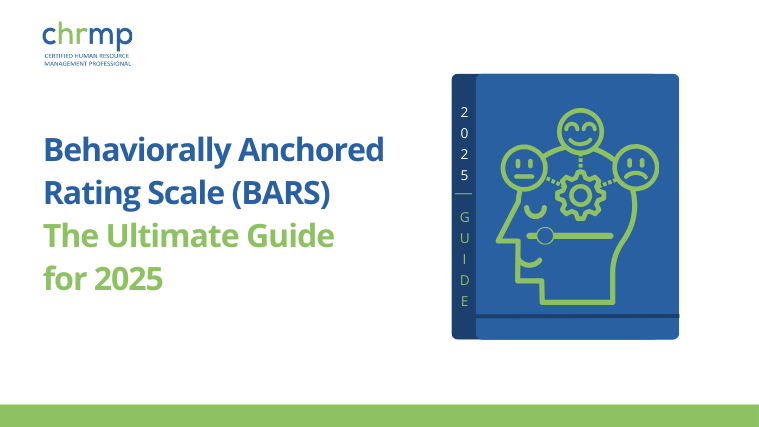

Performance appraisals are a cornerstone of human resources, acting as the primary tool for evaluating employee performance, setting goals, and identifying areas for improvement. Over the years, performance evaluation methods have evolved, driven by the need for more accuracy, fairness, and clarity in the assessment process.
Enter the Behaviorally Anchored Rating Scale (BARS)—a revolutionary method that has transformed how organizations approach performance appraisals. Unlike traditional rating scales, BARS focuses on specific behaviors tied to performance, offering a more objective, consistent, and accurate approach to evaluating employees.
In this section, we’ll dive deep into what BARS is, the evolution of performance appraisal methods, and why it has become a game-changer in employee evaluation. We’ll also compare BARS to traditional rating scales, highlighting the key differences and advantages.
At its core, a Behaviorally Anchored Rating Scale (BARS) is a performance evaluation method that combines the best features of both qualitative and quantitative assessment. Instead of relying on vague descriptors like “excellent” or “needs improvement,” BARS uses specific behavioral examples to assess performance. These behaviors are grouped into performance dimensions, each representing a key aspect of job performance.
For example, instead of simply rating a customer service representative on a scale from 1 to 5, BARS might list detailed behaviors, such as:
This method provides clear, concrete examples of what is expected at each performance level, making the evaluation process more transparent, understandable, and actionable for both employees and managers.
Performance appraisals have come a long way since their inception. Initially, evaluations were subjective and heavily relied on supervisors’ perceptions and general impressions of their employees’ performance. This often led to inconsistencies, biases, and unclear expectations. Over time, as organizations sought more reliable methods, new approaches emerged.
The traditional rating scale, such as graphic rating scales, was one of the first attempts to standardize performance evaluations. In this system, employees were rated on a numerical scale (e.g., 1 to 5) for different traits, such as communication skills, leadership, and technical expertise. However, these rating systems had their drawbacks, including:
To address these shortcomings, organizations began developing more behavioral-based rating systems, like BARS. These systems sought to identify the behaviors that contributed to performance success, linking specific actions to performance levels. This shift to behaviorally anchored rating scales marked a significant advancement in performance management, making evaluations more concrete, consistent, and aligned with organizational goals.
BARS has emerged as a game-changer in performance management for several reasons:
Performance evaluations are essential for an organization’s growth, and the way they are conducted significantly affects their impact on both employees and the organization. Here’s where Behaviorally Anchored Rating Scales (BARS) and traditional rating scales differ. The comparison below will help you understand how BARS is a more effective and reliable method of assessing employee performance.

1. Specificity vs. Generality
2. Objectivity vs. Subjectivity
3. Transparency
4. Alignment with Business Goals
5. Consistency and Fairness
While traditional rating scales can still serve as a basic tool for performance evaluation, Behaviorally Anchored Rating Scales (BARS) provide a much more refined, consistent, and objective way to assess employee performance. By focusing on specific behaviors, BARS eliminates ambiguity, reduces bias, and aligns evaluations with organizational goals.
With the growing demand for more precise and data-driven performance management systems, BARS stands out as an essential tool in any modern HR professional’s toolkit. As we move forward, BARS will continue to play a critical role in driving better performance outcomes, improving employee development, and fostering transparency and fairness in the workplace.
The Behaviorally Anchored Rating Scale (BARS) represents a significant advancement in employee performance management. By moving away from vague, subjective appraisals to a more structured, behavior-based approach, BARS provides clearer expectations, more consistent evaluations, and actionable feedback for both employees and managers. As companies continue to strive for higher productivity and better talent management, BARS is a critical tool for ensuring that performance appraisals are both fair and aligned with organizational objectives.
| Aspect | Behaviorally Anchored Rating Scale (BARS) | Traditional Rating Scales |
|---|---|---|
| Specificity | Clear, specific behaviors tied to performance levels. | Vague descriptors like “Good” or “Excellent”. |
| Objectivity | Reduces bias with standardized behavior ratings. | Subjective, open to personal interpretation. |
| Transparency | Employees know what’s expected for each rating. | Lacks clarity, leaving employees uncertain. |
| Business Alignment | Directly linked to business goals (e.g., customer satisfaction). | May not align with company objectives. |
| Consistency & Fairness | Ensures fairness with consistent criteria. | Inconsistent, as evaluators may focus on different criteria. |
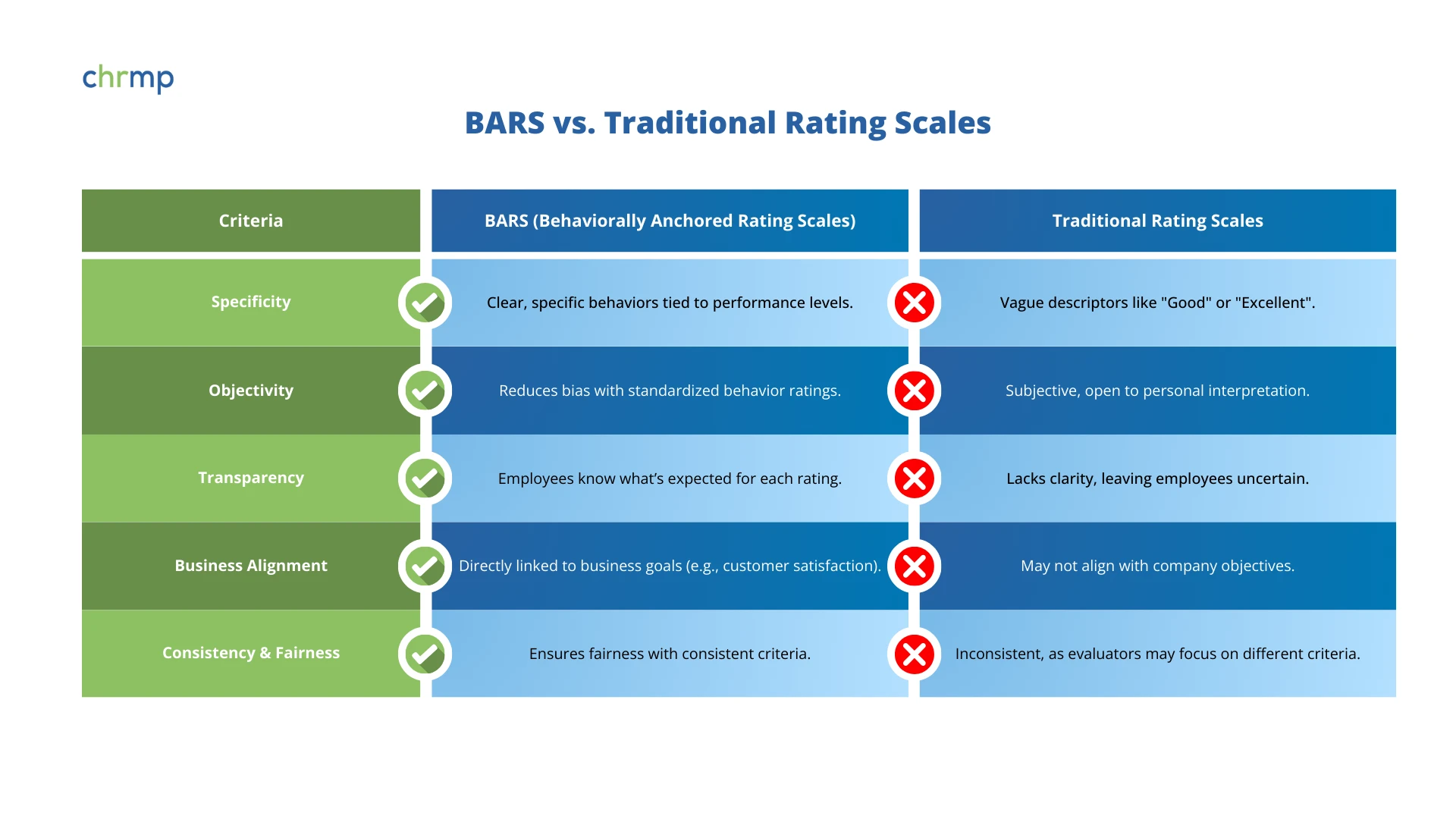
| Aspect | Behaviorally Anchored Rating Scale (BARS) | Traditional Rating Scales |
|---|---|---|
| Specificity | Clear, specific behaviors tied to performance levels. | Vague descriptors like “Good” or “Excellent”. |
| Objectivity | Reduces bias with standardized behavior ratings. | Subjective, open to personal interpretation. |
| Transparency | Employees know what’s expected for each rating. | Lacks clarity, leaving employees uncertain. |
| Business Alignment | Directly linked to business goals (e.g., customer satisfaction). | May not align with company objectives. |
| Consistency & Fairness | Ensures fairness with consistent criteria. | Inconsistent, as evaluators may focus on different criteria. |
Behaviorally Anchored Rating Scales (BARS) are designed to provide a structured and objective method for assessing employee performance. Unlike traditional rating systems that rely on vague descriptions, BARS focuses on specific behaviors that are linked to performance outcomes. The goal is to evaluate how well employees perform particular tasks or functions, using clear and observable actions, rather than subjective or general qualities.
The BARS approach is structured as follows:
Rating and Feedback: Employees are rated based on the predefined behaviors and the corresponding performance level. This results in a more detailed and consistent feedback process compared to traditional rating scales, which may simply rate employees as “good” or “bad” without specific examples.
The psychology of behavior-based assessments, such as BARS, is rooted in the principle that observable behaviors are the best predictors of job performance. Unlike traditional methods that may rely on subjective judgments or general impressions, BARS focuses on concrete actions and the direct outcomes of those actions.
Employee Motivation and Growth: Employees are more likely to engage in positive behaviors when they know exactly what is expected of them. The clarity provided by BARS not only encourages employees to align their performance with organizational goals but also fosters a sense of accountability and motivation to improve.
The key components of a BARS system work together to ensure that performance evaluations are fair, consistent, and objective. The main components include:
Calibration and Validation: BARS systems must be calibrated and validated to ensure that the behaviors defined are truly representative of successful performance. This can be done by gathering feedback from multiple stakeholders, such as managers, team members, and subject matter experts, and ensuring that the behaviors reflect the real-world performance of top employees.
The performance evaluation process is critical to any organization, shaping employee development, setting expectations, and aligning individual performance with broader business goals. However, traditional performance appraisal methods often suffer from inconsistencies, biases, and lack of clarity. That’s where the Behaviorally Anchored Rating Scale (BARS) comes in, offering a robust framework for assessing employee performance with greater objectivity, fairness, and alignment with organizational objectives.
Let’s break down how BARS plays a pivotal role in performance management and why it’s increasingly gaining popularity in organizations worldwide.
1. Improving Objectivity in Employee Evaluations
One of the main challenges with traditional performance appraisals is the subjectivity involved. Supervisors may rate employees based on personal biases or general impressions rather than specific, measurable criteria. This can lead to inconsistent ratings, unfair assessments, and employee dissatisfaction.
BARS directly addresses this issue by tying performance ratings to observable behaviors rather than vague descriptions like “good,” “satisfactory,” or “needs improvement.” These behaviors are clearly defined and tied to measurable performance standards for each role, making the evaluation process much more objective.
For example, consider a customer service representative being evaluated on the behavior of “resolving customer complaints effectively.” Rather than a subjective rating, a BARS evaluation would provide specific behavior examples at various performance levels:
By basing ratings on concrete, observable actions, BARS makes it easier for evaluators to objectively assess employee performance, ensuring fairness and reducing the chances of personal biases influencing the ratings.
2. Enhancing Fairness and Reducing Bias in Appraisals
Bias is a significant concern in performance appraisals, and traditional methods are often vulnerable to it. Factors like favoritism, halo effect (where one positive trait skews the overall rating), or recency bias (focusing too much on recent behavior rather than overall performance) can distort the evaluation process.
BARS helps reduce these biases by providing a structured and standardized framework for evaluating performance. Each employee is rated based on the same set of defined behaviors and performance criteria, ensuring that every individual is assessed fairly, according to the same standards.
For instance, in an office management role, BARS would focus on specific behaviors related to organizational skills, communication, and problem-solving:
By focusing on specific, predefined behaviors rather than general judgments, BARS ensures that all employees are evaluated based on their actual contributions and performance, eliminating much of the bias seen in traditional appraisals.
3. Aligning Performance Ratings with Business Goals
One of the most powerful aspects of BARS is its ability to align individual performance with the strategic objectives of the organization. Traditional performance appraisal systems often focus on generic traits or competencies that may not directly relate to the company’s specific goals or values. In contrast, BARS allows organizations to customize performance dimensions to reflect what’s truly important to the company’s success.
For example, in a sales organization, BARS can evaluate employees on behaviors that directly align with the company’s sales goals:
By linking specific performance behaviors to organizational objectives, BARS ensures that employees are not only evaluated on their job duties but also on how their efforts contribute to the broader success of the organization. This approach helps foster a stronger sense of alignment between individual and company goals, driving performance in the right direction.
4. How BARS Impacts Employee Motivation and Development
Employee motivation is greatly influenced by the clarity of expectations and the quality of feedback they receive. BARS plays a significant role in boosting employee motivation by providing clear, actionable feedback based on observable behaviors.
When employees understand what behaviors are expected of them and how they will be evaluated, they are more likely to be motivated to align their efforts with those expectations. The clarity offered by BARS helps employees focus on improving specific aspects of their performance that directly impact their ratings.
Developmental Impact of BARS
Moreover, BARS encourages employee development by pinpointing the exact areas where improvement is needed. Since each rating is anchored to specific behaviors, employees can see exactly where they are excelling and where they need to grow. This detailed feedback is invaluable for personal and professional development.
For example, if a marketing manager receives feedback using BARS that highlights their failure to delegate effectively (e.g., “Tends to take on too many tasks, leading to delays and overwhelmed team members”), they can focus on improving delegation skills as part of their development plan.
Increased Motivation Through Clear Pathways
Furthermore, by offering ratings that are tied to specific behaviors, BARS helps set clear goals for improvement. When employees see the tangible link between their efforts and their performance ratings, they are more motivated to put in the effort to meet those expectations. This, in turn, can enhance their overall job satisfaction and foster a sense of achievement.
The Crucial Role of BARS in Performance Management
In conclusion, Behaviorally Anchored Rating Scales (BARS) bring a level of precision, fairness, and clarity that traditional performance appraisal methods often lack. By tying performance evaluations to specific, observable behaviors, BARS ensures that employees are assessed fairly and in alignment with business goals. Moreover, BARS provides meaningful feedback that enhances employee motivation, development, and engagement, ultimately leading to improved performance across the board.
Creating a Behaviorally Anchored Rating Scale (BARS) system is a multi-step process that involves collaboration, research, and careful planning to ensure accuracy and alignment with your organization’s goals. The beauty of BARS lies in its specificity, which means that each employee’s performance is measured against clear, concrete behaviors rather than vague or subjective criteria.
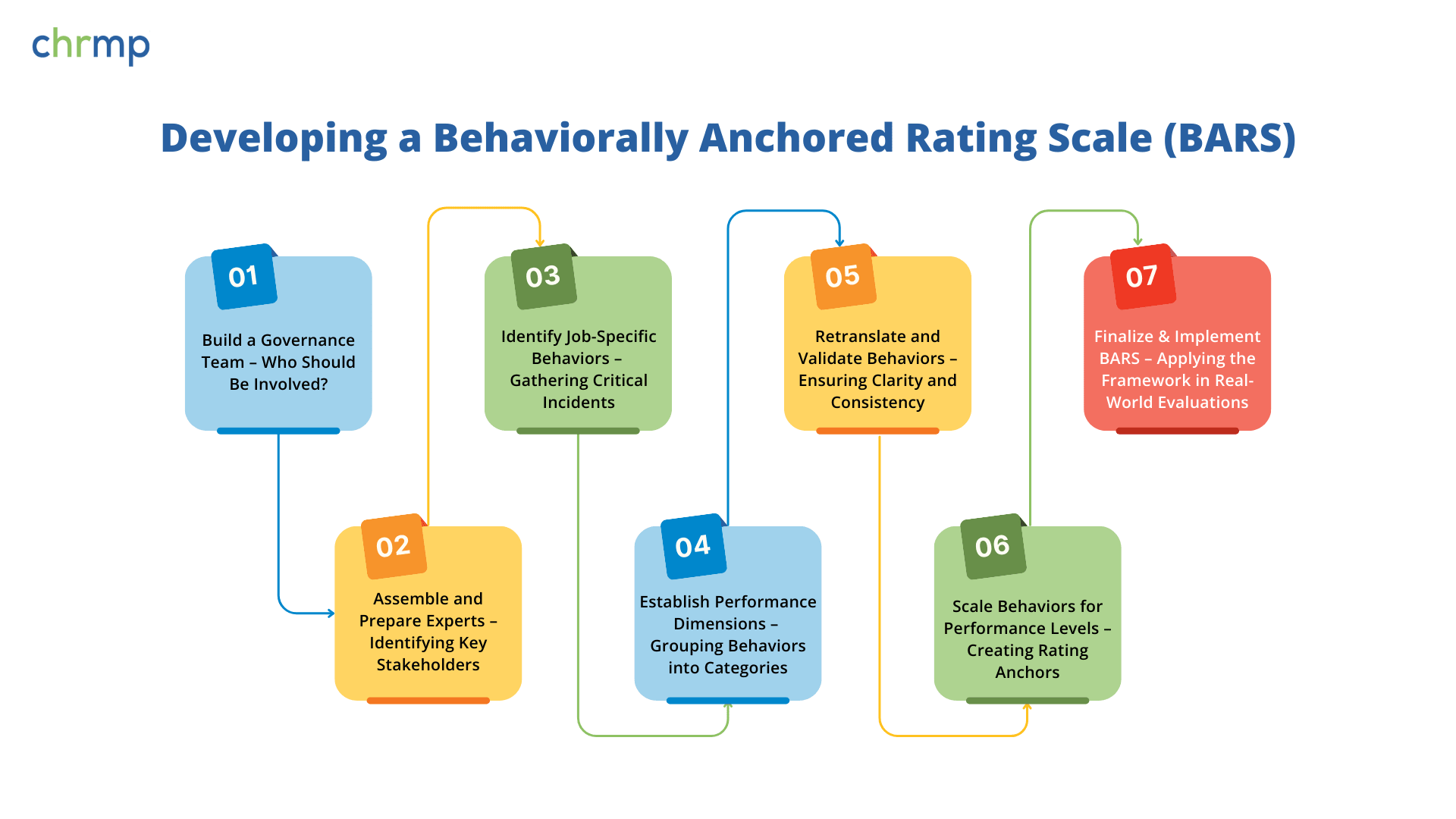
Let’s break down the process of building a BARS system and see how you can create an effective framework for performance management in your organization.
Step 1: Build a Governance Team – Who Should Be Involved?
To ensure that your BARS system is effective and aligned with your organization’s goals, you need to start by building a governance team. This team will be responsible for overseeing the entire process of developing and implementing BARS. A governance team typically includes a mix of HR professionals, department heads, and key stakeholders from various functional areas of the organization.
Who should be involved?
By forming a cross-functional team, you’ll get diverse perspectives that ensure the BARS system is comprehensive, balanced, and relevant to all parts of the organization.
Step 2: Assemble and Prepare Experts – Identifying Key Stakeholders
Once your governance team is in place, it’s time to assemble the experts who will help with the technical aspects of developing the BARS system. These experts are usually employees or consultants who have a deep understanding of performance management, behavioral psychology, and job analysis.
Key experts you may need:
These experts will be essential for ensuring that the BARS system is well-designed and well-integrated into your HR processes.
Step 3: Identify Job-Specific Behaviors – Gathering Critical Incidents
The next step in developing BARS is identifying job-specific behaviors. This means understanding what observable actions employees need to exhibit in order to perform successfully in their roles. Instead of relying on broad characteristics or vague assessments, BARS focuses on tangible actions tied directly to performance outcomes.
One of the most effective ways to identify these behaviors is through critical incident technique (CIT). CIT is a research method where you gather real-world examples from current employees about times when they either performed exceptionally well or poorly. These incidents provide valuable insights into what behaviors lead to success or failure in a particular role.
How to gather critical incidents:
Example: In a customer service role, a critical incident might be: “A customer called in with a complex issue. The employee calmly listened, asked the right questions, and resolved the issue within 15 minutes. The customer gave positive feedback, and the issue was resolved without escalation.”
By gathering critical incidents like this, you ensure that your BARS system is built on real-world examples, making it more reliable and applicable.
Step 4: Establish Performance Dimensions – Grouping Behaviors into Categories
Once you’ve gathered enough information about the key behaviors that contribute to success, the next step is to group those behaviors into performance dimensions. Performance dimensions represent the categories or areas of performance that are critical for success in a given role. Each dimension reflects a different aspect of job performance that you want to evaluate.
For example:
How to organize these dimensions:
By organizing these behaviors into dimensions, you ensure that the BARS system covers all critical aspects of job performance and that employees receive clear feedback in areas that matter most.
Step 5: Retranslate and Validate Behaviors – Ensuring Clarity and Consistency
Once you’ve gathered job-specific behaviors and grouped them into performance dimensions, the next critical step is to retranslate and validate these behaviors to ensure they are clear, consistent, and applicable to the roles they are meant to evaluate. This step ensures that the behaviors included in the BARS system are not only realistic but also truly reflective of the job’s requirements.
Retranslating behaviors involves refining the language used to describe the performance dimensions. You want to ensure that each behavior is easy to understand, action-oriented, and free from ambiguity.
For example, if one behavior is described as “communicates effectively with customers,” you might retranslate it to make it more specific and observable, like:
This makes the behavior more measurable and leaves less room for different interpretations.
The validation process ensures that the behaviors are indeed representative of successful performance in the given role. Validation is usually done through feedback loops, involving managers, HR professionals, and employees who are directly involved in the role. You may validate the behavior by:
By retraining the behaviors for clarity and validating them for accuracy, you’ll ensure that your BARS system aligns perfectly with real-world job requirements and contributes to meaningful and actionable evaluations.
Step 6: Scale Behaviors for Performance Levels – Creating Rating Anchors
Once you’ve identified and validated the behaviors, the next step is to scale these behaviors into performance levels. This process is essential for translating the observed behaviors into a consistent and measurable scale.
Performance levels allow you to evaluate how well an employee is performing according to specific behaviors. Rating scales are typically broken down into 3-7 levels, with each level describing different degrees of performance, from exceptional to needs improvement. The levels help to differentiate between varying levels of competence in the same performance dimension.
How to Create Rating Anchors
Rating anchors are the descriptions that correspond to each performance level for each behavior. For example:
Each level should have clearly defined, observable behaviors that describe what is expected at that specific rating. To make the ratings more objective and applicable, be sure the behaviors are based on real performance data rather than theoretical or idealistic standards.
Rating Scale Example:
| Level | Behavioral Anchor |
| Level 5 | Consistently exceeds expectations, providing excellent service and driving superior customer experiences. |
| Level 4 | Frequently meets expectations and provides solid service. |
| Level 3 | Meets basic expectations but sometimes requires assistance with more complex situations. |
| Level 2 | Occasionally fails to meet expectations, often needing guidance or additional support. |
| Level 1 | Rarely meets expectations, requires constant supervision, and impacts team effectiveness. |
Tip: The more specific and behaviorally focused the anchors, the more effectively you can apply the system across a large number of employees. Avoid abstract terms like “good communicator” or “team player.” Instead, focus on what concrete actions and results define those behaviors.
Step 7: Finalize and Implement BARS – Applying the Framework in Real-World Evaluations
The final step in creating and implementing a BARS system is to finalize and deploy the framework for real-world performance evaluations. After all the groundwork, testing, and validation, it’s time to put the system into action across the organization.
Example: A sales team may use the BARS system to evaluate specific behaviors, such as how well team members handle customer inquiries, their ability to close sales, and their contribution to achieving team goals. The system should ensure that all team members are evaluated fairly, with each manager rating the same behaviors in a consistent manner.
is both constructive and aligned with business goals. As you move forward in implementing your BARS system, be sure to remain open to feedback and continuously refine your approach to ensure that it meets the evolving needs of your workforce.
One of the greatest advantages of the Behaviorally Anchored Rating Scale (BARS) system is its versatility—it can be used not just for performance reviews, but across the entire employee lifecycle. From the moment a candidate enters your pipeline to when they’re considered for a leadership role, BARS provides a structured and behavior-focused approach that supports talent decisions with clarity and consistency.
Let’s break down how BARS integrates across four key stages of the employee journey:
1. Talent Acquisition: Using BARS in Hiring Decisions
BARS can be a powerful tool even before someone becomes an employee. During the recruitment process, incorporating behavior-based criteria into interviews ensures that hiring managers are not relying on gut instinct or subjective impressions. Instead, they’re evaluating candidates on predefined behaviors that are aligned with role success.
✅ Example Use Case: A customer support team uses a BARS-based interview guide to assess how candidates respond to conflict situations. Instead of asking generic questions like “Tell me about a time you handled a difficult customer,” they use behaviorally anchored scenarios with clear rating scales—like:
By embedding BARS into hiring panels, organizations can assess future performance more accurately and select candidates who already demonstrate the desired behaviors.
2. Training and Development: Identifying Skill Gaps
Once employees are onboarded, BARS becomes a valuable tool for identifying skill gaps and designing relevant development programs. Because BARS defines performance across specific behavioral indicators, it’s easier to spot exactly where an employee may need support.
✅ Example Use Case: A mid-level manager is being reviewed using BARS for leadership competencies. In the “Team Empowerment” dimension, they are consistently rated a 2 out of 5, where:
This clarity helps the HR team create a targeted development plan involving coaching and delegation training, rather than a generic leadership program.
BARS enables personalized development by identifying behavioral shortcomings—not just outcomes—and gives employees a clear roadmap for improvement.
3. Performance Reviews: Delivering Structured Feedback
Traditional performance reviews often suffer from vague ratings and subjective feedback. BARS brings structure, specificity, and fairness to this process.
With BARS, managers are equipped with a performance scale anchored to real-world behaviors, making feedback easier to understand and less prone to bias. It also removes ambiguity for employees—no more wondering what a “3 out of 5” actually means.
✅ Example Use Case: In a BARS-based performance review for a software developer, one dimension might be “Code Quality and Efficiency.”
By mapping actual performance to these anchors, the developer understands exactly where they stand and what improvement looks like. This promotes accountability and makes the review process constructive rather than confrontational.
4. Career Growth and Promotions: Measuring Readiness for Advancement
Promotions often fail when based purely on seniority or subjective impressions. BARS offers a more reliable alternative by assessing whether an employee has already demonstrated the behaviors required at the next level.
✅ Example Use Case: A sales executive aiming for a team lead role is evaluated using a BARS model that includes “Mentoring Peers” as a dimension.
If the executive consistently scores at Level 4 or 5, this provides objective evidence that they are ready to take on leadership responsibilities—supporting a data-driven promotion decision.
This approach ensures that advancement is based on proven behaviors, not just potential or popularity, which builds fairness and trust in your internal mobility programs.
When BARS is embedded across the employee lifecycle—from recruitment to promotion—it transforms how talent is assessed, developed, and rewarded. It ensures that employees are judged not just on outcomes, but on how those outcomes are achieved, promoting a culture of fairness, transparency, and continuous improvement.
To understand the real value of the BARS framework, it’s helpful to see how it looks in action. Below are industry-specific BARS examples that show how different job roles can be evaluated using behavior-based rating anchors. These examples highlight the specificity and clarity that BARS brings to performance management, eliminating vague evaluations and allowing for focused feedback and development.
Customer Service Representative BARS Example
Performance Dimension: Handling Customer Complaints
| Rating | Behavioral Anchor |
|---|---|
| 5 – Outstanding | Proactively identifies potential issues, resolves customer complaints efficiently without escalation, and follows up to ensure satisfaction. |
| 4 – Exceeds Expectations | Resolves most complaints independently with minimal guidance and maintains a calm, professional demeanor. |
| 3 – Meets Expectations | Responds to complaints following script/protocol and seeks help when necessary. |
| 2 – Needs Improvement | Struggles to manage complaints without supervision and occasionally misses critical resolution steps. |
| 1 – Unsatisfactory | Frequently escalates basic issues or reacts emotionally, leading to unresolved or prolonged complaints. |
✅ Application: This BARS model helps evaluate frontline staff with clear behavioral expectations. It not only guides performance reviews but also identifies training needs (e.g., conflict resolution or empathy training).
Software Developer BARS Example
Performance Dimension: Code Quality and Collaboration
| Rating | Behavioral Anchor |
| 5 – Outstanding | Writes clean, well-documented, efficient code that passes peer reviews with no revisions. Actively mentors peers and proposes process improvements. |
| 4 – Exceeds Expectations | Regularly delivers high-quality code and contributes to team discussions and problem-solving. |
| 3 – Meets Expectations | Code meets functional requirements, with occasional review feedback; works well with the team. |
| 2 – Needs Improvement | Code frequently has bugs or lacks documentation. Participates in team efforts passively. |
| 1 – Unsatisfactory | Consistently submits low-quality code, misses deadlines, and avoids collaboration. |
✅ Application: Useful during performance appraisals and promotion assessments. A developer scoring a consistent 4 or 5 may be ready for tech lead responsibilities.
Sales Executive BARS Example
Performance Dimension: Prospecting and Lead Conversion
| Rating | Behavioral Anchor |
| 5 – Outstanding | Consistently exceeds quotas, develops long-term client relationships, and generates referrals. Coaches others on prospecting techniques. |
| 4 – Exceeds Expectations | Frequently exceeds targets and nurtures leads independently through the funnel. |
| 3 – Meets Expectations | Meets sales targets and follows established processes to engage prospects. |
| 2 – Needs Improvement | Struggles to meet targets; requires frequent guidance in engaging or converting leads. |
| 1 – Unsatisfactory | Fails to meet sales objectives; shows poor follow-through on leads or client interactions. |
✅ Application: This BARS structure enables sales managers to identify reps who need more support or those who are ready to move into account management or mentorship roles.
Healthcare Professional BARS Example (e.g., Registered Nurse)
Performance Dimension: Patient Care and Communication
| Rating | Behavioral Anchor |
| 5 – Outstanding | Demonstrates exceptional compassion and clinical judgment, anticipates patient needs, and communicates clearly with patients and families. |
| 4 – Exceeds Expectations | Maintains thorough care documentation, consistently follows protocols, and provides reassurance to patients. |
| 3 – Meets Expectations | Delivers standard care as per guidelines, communicates clearly when prompted. |
| 2 – Needs Improvement | Occasionally overlooks care steps or delays communication with patients or families. |
| 1 – Unsatisfactory | Misses critical care steps, poorly documents procedures, or fails to communicate vital information. |
✅ Application: Perfect for use in hospitals and clinics where patient experience and quality of care are critical. The BARS model aligns nursing performance with both safety standards and empathetic communication benchmarks.
Why These Examples Matter
These examples show that BARS can be tailored to virtually any role, industry, or function. What they all have in common is a shift from rating vague traits like “teamwork” or “dependability,” to evaluating observable behaviors that directly reflect job success.
By using BARS in this way, organizations can:
The Behaviorally Anchored Rating Scale (BARS) is a powerful tool in modern performance management. By focusing on observable, job-related behaviors, BARS offers organizations a more accurate, fair, and transparent way of evaluating employees. As we’ve seen in the examples above, BARS can be applied across various industries, from customer service to healthcare, ensuring that performance appraisals are tailored to specific roles and expectations. The structure of BARS ensures that employees receive clear, actionable feedback that can drive improvement and enhance performance.
While BARS offers a structured and behavior-based approach to performance evaluation, it’s not the only method available. Depending on the organization’s size, goals, and culture, other performance appraisal systems may be more appropriate—or they may be used in combination with BARS. Let’s explore some commonly used alternatives:
1. Graphic Rating Scales
Overview: This is one of the most traditional and widely used performance evaluation tools. Employees are rated on a scale (usually 1 to 5 or 1 to 10) across various traits or competencies such as communication, dependability, teamwork, and initiative.
Pros:
Cons:
Use Case: Graphic rating scales are often used in organizations where speed and simplicity in appraisals are prioritized, such as in retail or hospitality industries.
2. Management by Objectives (MBO)
Overview: Introduced by Peter Drucker, MBO evaluates performance based on the achievement of specific, measurable goals. These objectives are jointly set by the employee and the manager at the beginning of the performance cycle.
Pros:
Cons:
Use Case: MBO works well in sales, project management, and executive roles where results and deliverables can be quantified easily (e.g., “Increase client retention rate by 20% in Q2”).
3. 360-Degree Feedback Evaluations
Overview: This method gathers feedback from multiple sources—managers, peers, direct reports, and sometimes even customers. It provides a holistic view of an employee’s performance, especially around interpersonal skills and leadership qualities.
Pros:
Cons:
Use Case: Ideal for leadership roles, cross-functional teams, or in organizations emphasizing collaboration and culture. For example, a product manager may be evaluated by design, marketing, and development teams.
4. Ranking and Forced Distribution Methods
Overview:
Pros:
Cons:
Use Case: These methods were famously used by companies like GE during the Jack Welch era, though they’ve become less popular due to employee morale concerns. Still, some companies use them during layoffs or in performance improvement programs.
So, When Should You Use BARS Over These Alternatives?
While each performance rating system has its place, BARS stands out when:
That said, many companies combine methods—for instance, using BARS for performance behaviors, MBO for measurable outcomes, and 360-degree feedback for leadership or team-based roles.
No performance appraisal method is perfect. Each brings its own strengths and limitations depending on how and where it’s applied. The Behaviorally Anchored Rating Scale (BARS) stands out for its structure, clarity, and emphasis on actual behaviors—but it’s not without its challenges.
Let’s dive into a well-rounded view of the advantages and disadvantages of using BARS in your performance management strategy.
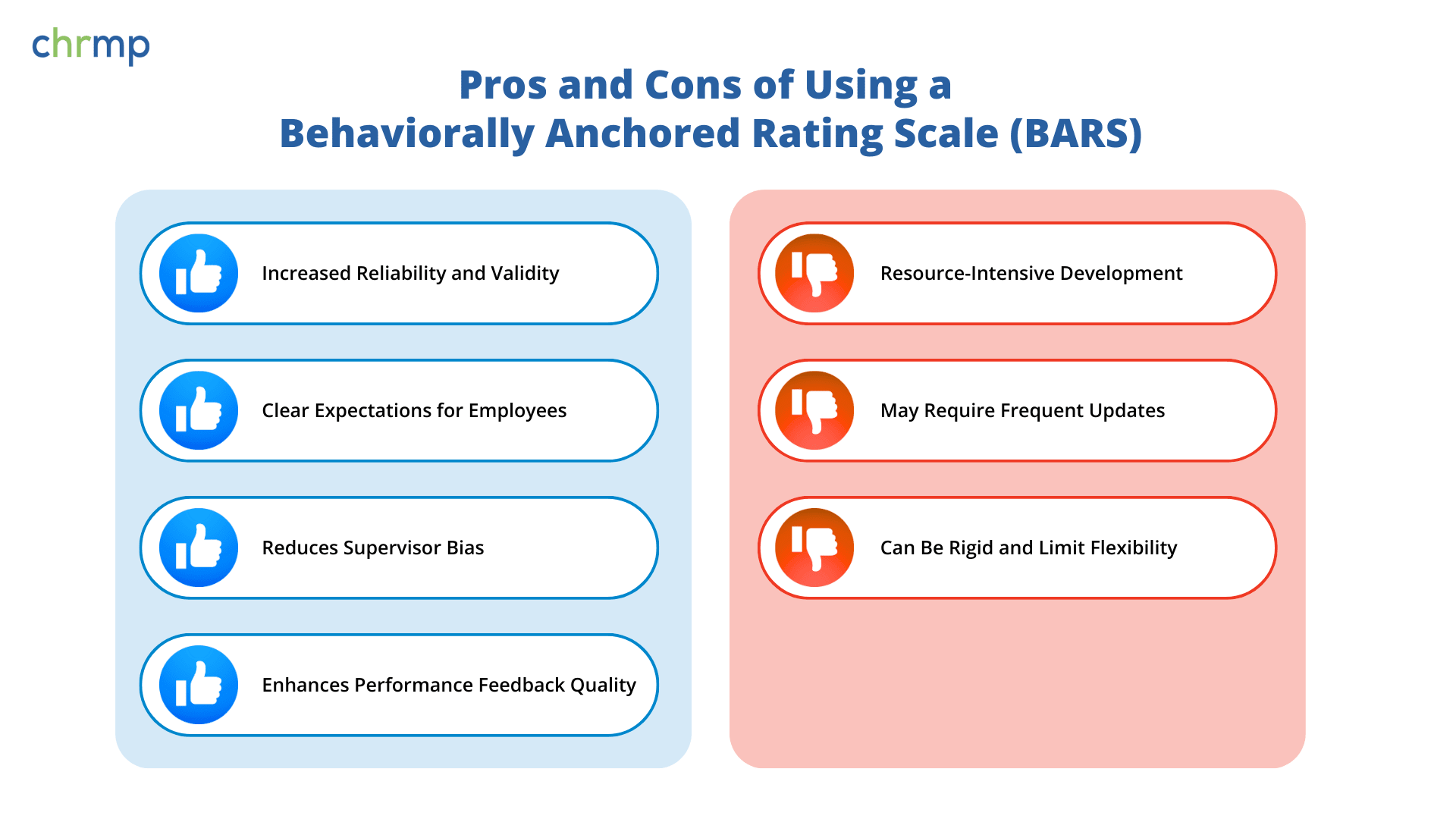
1. Increased Reliability and Validity
BARS uses real, observable behaviors to rate performance. This eliminates vague criteria like “communication skills” or “leadership ability” and replaces them with concrete examples.
📌 Example: Instead of rating an employee a “4 out of 5” on “teamwork” without context, BARS defines a Level 4 behavior as: “Often initiates group collaboration, mediates disagreements constructively, and encourages team input.”
Because every rating is tied to a specific action, managers are more likely to rate consistently, and employees can understand how they’re being assessed. This enhances both inter-rater reliability and the validity of the performance reviews.
2. Clear Expectations for Employees
Employees want to know what’s expected of them—and BARS delivers that clarity.
Each rating level includes behavioral anchors, which serve as examples of what constitutes average, excellent, or poor performance. This removes ambiguity and helps employees self-assess their work more accurately.
📌 Example: A sales executive knows that to achieve a “Level 5” in prospecting, they must “consistently exceed quotas, provide creative outreach, and close high-value leads independently.”
BARS not only guides evaluations—it guides daily behavior.
3. Reduces Supervisor Bias
Traditional appraisal methods often suffer from rater bias—whether it’s the halo effect, recency effect, or personal preferences.
By using behaviorally anchored statements, BARS makes it harder for managers to let subjective feelings or impressions skew their ratings. It focuses attention on what employees actually do—not who they are or how managers feel about them.
📌 Realistic Scenario: Instead of rating someone higher just because “they’re always nice,” a manager has to ask: Did this employee exhibit the behavior described at Level 4 or 5 in this competency?
This structured accountability leads to fairer evaluations across the board.
4. Enhances Performance Feedback Quality
Ever received a performance review that left you wondering, “What does a 3 even mean?”
BARS replaces vague numerical ratings with rich, descriptive behaviors. This makes performance conversations more meaningful and actionable.
📌 Example: Telling an employee, “You’re currently at Level 3, which means you provide helpful input in meetings but tend to wait for prompts. To reach Level 4, aim to take initiative and lead discussions more often.” is far more valuable than simply saying, “Your teamwork score is average.”
For managers, this makes difficult feedback easier to deliver. For employees, it makes growth more achievable.
1. Resource-Intensive Development
Creating a BARS system isn’t as simple as downloading a template or tweaking an existing form. It involves a deep, collaborative process that includes:
📌 Reality Check: This process can take weeks or months per role, particularly in larger organizations with diverse job functions.
If not done correctly, the system can fail to reflect the real job responsibilities, leading to frustration rather than clarity.
2. May Require Frequent Updates
Workplace roles are constantly evolving, especially in dynamic fields like tech, healthcare, or digital marketing. A behavior deemed “Level 5” today might be standard practice next year.
To stay relevant and effective, BARS systems need regular review and updates.
📌 Challenge: If your HR team lacks the capacity to update scales annually, the BARS tool might fall behind the pace of change—leading to outdated evaluations and confusion among employees.
3. Can Be Rigid and Limit Flexibility
Because BARS defines performance so specifically, it can be rigid in fast-changing environments or for roles that are creative and fluid in nature.
Some managers may find it restrictive if an employee’s performance doesn’t exactly match the behavior anchors—even if the results are strong.
📌 Example: A top-performing content creator who breaks the mold may not fit neatly into the predefined behavioral buckets, making it harder to rate them fairly.
BARS works best in structured, repeatable roles (e.g., customer service, operations) but may be less effective for highly creative or hybrid roles where flexibility and innovation are harder to quantify.
So, is BARS worth the investment?
The answer lies in your organization’s goals, resources, and workforce structure. If you value consistency, behavioral clarity, and data-driven evaluations—and can commit the resources to develop and maintain the system—BARS can significantly elevate your performance management process.
But if your environment is fluid, or your team lacks the time to build role-specific scales, consider complementing BARS with more adaptable tools like 360-degree feedback or management by objectives (MBO).
A well-designed Behaviorally Anchored Rating Scale (BARS) system provides structured, objective, and meaningful performance evaluations, but how do you ensure it’s actually delivering on these promises? The answer lies in BARS analytics—tracking the effectiveness of the system through Key Performance Indicators (KPIs) and continuous refinement.
Let’s explore how HR professionals can measure, track, and optimize BARS for maximum impact.
To evaluate whether BARS is working effectively, organizations should monitor key HR performance metrics. Some of the most relevant KPIs include:
✅ Inter-Rater Reliability
✅ Employee Performance Improvement Rate
✅ Manager Satisfaction with BARS
✅ Employee Understanding of Expectations
✅ Performance Review Completion Rate
BARS is designed to reduce bias and inconsistencies, but HR teams must regularly audit its effectiveness. Here’s how:
1. Conduct Inter-Rater Consistency Checks
2. Perform Rating Distribution Analysis
3. Correlate BARS Ratings with Business Outcomes
4. Employee and Manager Feedback Sessions
“Are certain behaviors missing from the scale?”
HR analytics isn’t just about tracking performance—it’s also about continuous improvement. Here’s how you can refine BARS over time using real data:
1. Identify Trends in Ratings
Employees aren’t being provided the right development opportunities.
2. Use AI and Machine Learning for Insights
3. Compare Performance Scores with Retention Rates
Not being used consistently across managers.
4. Adjust Behaviors Based on Market Trends
With the rise of AI-driven content creation, HR may need to update the performance criteria.
While BARS is highly structured, its implementation is not without hurdles. Here are some common challenges and proven solutions: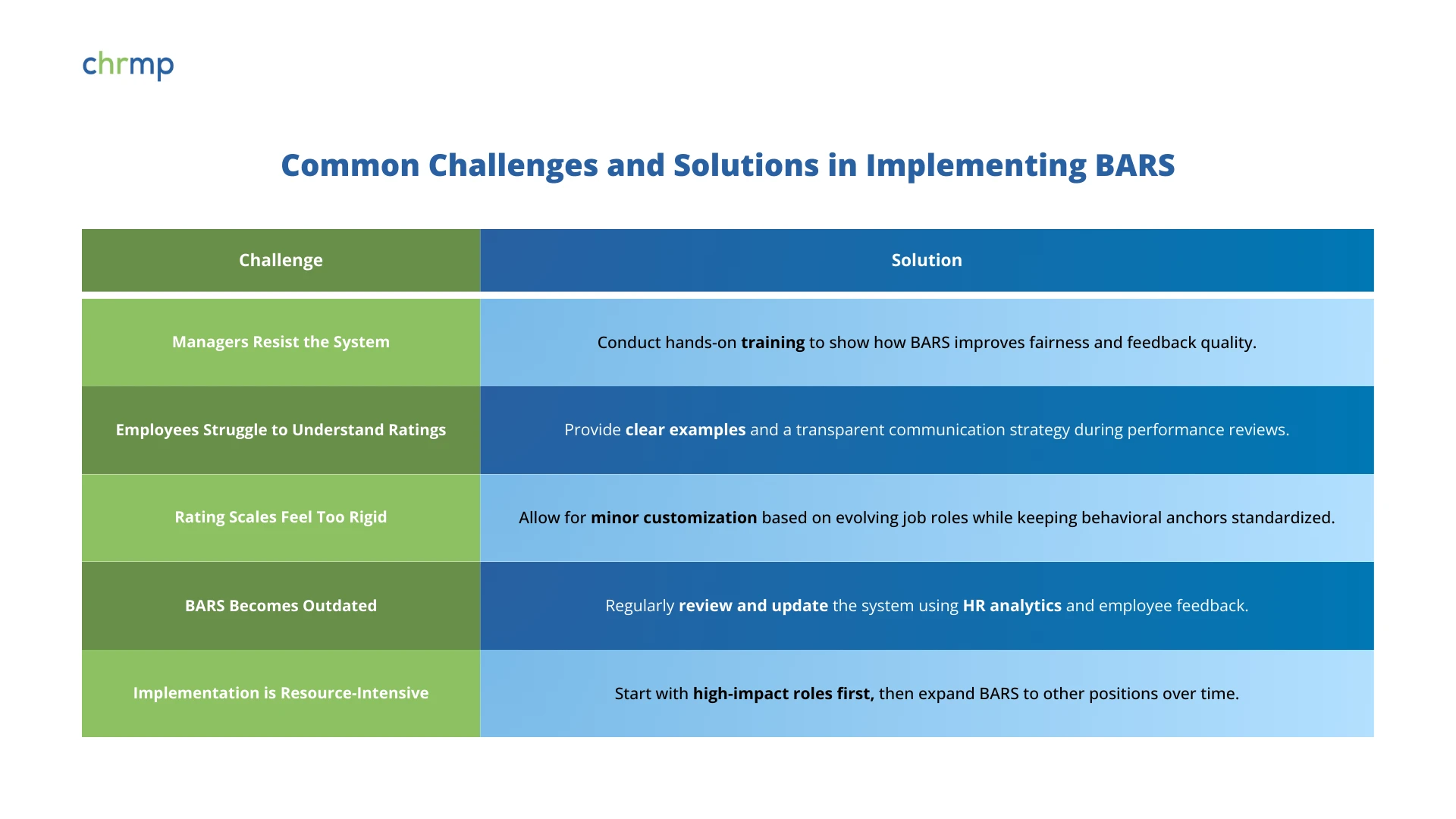
The success of BARS depends on continuous monitoring and refinement. By integrating HR analytics, employee feedback, and market trends, organizations can ensure that their performance evaluation system remains fair, relevant, and actionable.
The workplace is evolving rapidly, and performance evaluation methods must keep pace. Traditional BARS systems, while structured and effective, are being reimagined with the help of AI, machine learning, and data-driven insights. Organizations are now focusing on making BARS more adaptive, scalable, and precise, ensuring that performance assessments align with modern job roles and workforce expectations.
Let’s explore how BARS is evolving to meet the future demands of performance management.
The integration of artificial intelligence (AI) in performance evaluations is revolutionizing how employee behaviors are assessed and rated. AI tools can analyze work patterns, communication styles, and collaboration levels, providing objective, real-time insights into employee performance.
✅ Automated Behavior Tracking – AI-driven tools can analyze employee interactions (emails, meetings, project contributions) and map behaviors to BARS rating anchors.
✅ Real-Time Feedback – AI-powered dashboards offer continuous performance monitoring, rather than waiting for annual reviews.
✅ Bias Reduction – AI removes human bias by evaluating behaviors based on data rather than subjective opinions.
📌 Example: AI-powered platforms like Microsoft Viva Insights and Workday Adaptive Insights already use behavior analytics to assess employee engagement and productivity, helping managers make data-backed performance evaluations.
One limitation of traditional BARS models is their rigid structure, which can become outdated as job roles evolve. The future of BARS is customization and adaptability, allowing organizations to adjust behavior anchors dynamically.
✅ Role-Specific Adjustments – Organizations can modify behavior anchors based on changing job requirements or industry trends.
✅ Employee-Initiated Feedback – Employees can self-assess and suggest modifications to performance criteria, making the process more collaborative.
✅ Industry-Specific Customization – HR teams can tailor BARS models for different industries, ensuring relevance across tech, healthcare, finance, etc.
📌 Example: A software development team might update its BARS model to include AI-assisted coding behaviors, reflecting the shift towards automation in coding practices.
Machine learning (ML) algorithms can refine BARS models by identifying patterns in employee behavior and predicting future performance trends.
✅ Predictive Performance Analysis – ML models can analyze past performance data to forecast future success or potential skill gaps.
✅ Personalized Learning Paths – By tracking performance trends, ML can recommend customized training programs to address weaknesses.
✅ Continuous Improvement – ML-driven feedback loops ensure BARS models stay relevant, automatically suggesting new behavior anchors based on workforce data.
📌 Example: A company using AI-driven HR analytics may find that employees with high BARS scores in leadership behaviors tend to have better team retention rates—helping HR teams make better leadership promotion decisions.
Companies are moving away from rigid, annual performance reviews and adopting more dynamic, real-time evaluation methods. The future of BARS and performance assessments will be:
✅ More Frequent & Agile – Organizations will move toward quarterly or even continuous performance tracking, reducing reliance on yearly reviews.
✅ Employee-Driven – Employees will play a more active role in shaping their evaluation criteria, ensuring fairness and engagement.
✅ Integrated with Business Strategy – Performance ratings will align more closely with real-time business goals and company KPIs.
📌 Example: Companies like Deloitte and Adobe have already shifted away from annual performance reviews to more frequent, real-time feedback models, integrating BARS principles into agile evaluation frameworks.
The Behaviorally Anchored Rating Scale (BARS) is no longer just a static performance review tool—it’s evolving into a dynamic, AI-driven, and employee-focused evaluation system. Organizations that embrace AI-powered analytics, customizable frameworks, and machine learning enhancements will gain a competitive edge in workforce development.
By making BARS more adaptive, data-driven, and aligned with modern work environments, HR leaders can ensure that performance evaluations are fair, transparent, and truly impactful.
🚀 Are you ready to transform your performance management strategy with the future of BARS? Now is the time to innovate!
1. What makes BARS different from other performance evaluation methods?
BARS focuses on observable behaviors rather than subjective opinions, making it a more structured and fair evaluation system. Unlike traditional rating scales, BARS provides specific behavioral examples at each rating level.
2. Can BARS be applied to all job roles?
Yes, BARS can be customized for any industry or role, including customer service, IT, healthcare, sales, and leadership positions. However, it works best in roles where clear behavioral expectations can be defined.
3. How often should BARS frameworks be updated?
BARS should be reviewed annually or whenever significant job role changes occur. AI-driven HR analytics can help identify outdated behaviors and suggest updates.
4. How does BARS improve employee feedback?
Because BARS links performance scores to real behaviors, employees receive clear, actionable feedback instead of vague ratings. This helps them understand exactly how to improve.
5. Is BARS suitable for remote work environments?
Yes! With the rise of hybrid and remote work, BARS can be adapted to include behaviors like virtual collaboration, remote project management, and digital communication.
BARS is no longer just a rating scale—it’s evolving into a strategic workforce management tool. By integrating AI, machine learning, and real-time analytics, organizations can ensure fair, effective, and future-ready performance evaluations.

© 2007-2025 CHRMP| All Rights Reserved | Powered by Ripples Learning & Research Private Limited
